Hitachi Deskstar 7K1000 in RAID 0: Is Two Terabytes really better than One?
by Gary Key on April 19, 2007 12:15 AM EST- Posted in
- Storage
Actual Application Performance
Our application benchmarks are designed to show application performance results with times being reported in seconds, with lower scores being better. While these tests will show some differences between the drives it is important to understand we are no longer measuring the pure performance of the hard drive but how well our platform performs with each individual drive. In that sense, these are the more real-world tests that show how hard drives and RAID 0 can impact your everyday computer use.
The performance of a hard drive is an integral part of the computer platform but other factors such as memory, CPU, core logic, and even chipset driver choices can play a major role in determining how well the hard drive performs in any given task. Also worth noting is that new features of Windows Vista - specifically SuperFetch - can further reduce the measured performance differences between hard drives.
Game Load Tests
In our Half-Life 2: Lost Coast test we measure the time it takes to load the game with the application timer starting when the play game icon is initiated in the Steam menu until the main game menu appears.
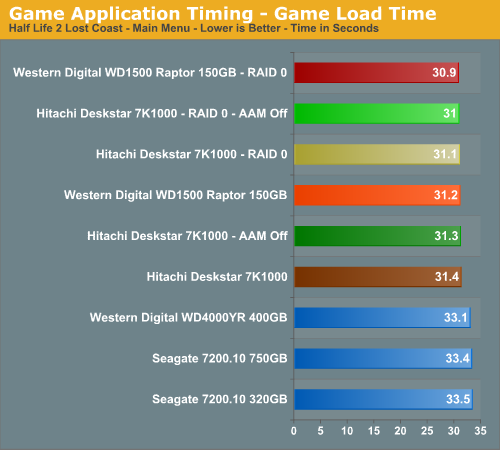
The results speak for themselves with the RAID 0 setups offering extremely minor performance improvements in actual game load testing. You will likely not be able to notice any differences during actual game play with a RAID 0 setup. We know it was impossible for us.
Our Sims 2 - Open for Business test measures the time it takes to load the initial portion of the game. Our application timer starts when the game icon is initiated until the neighborhood menu appears.

We witnessed 38% to 50% improvements in our iPeak tests in this game but measure less than a 2% difference in actual game load times. Without a benchmark, these differences are impossible to witness during actual game play. Once again, we see the Raptors slightly ahead but the 7K1000 for all intents and purposes is even in our game benchmarks.
Game Level Load
This test centers on the actual loading of a playable level within our game selections. We run Battlefield 2 and measure the time it takes to load the Daqing Oilfields level. Our application timer begins when the start single player icon is initiated and ends when the join game icon is visible.
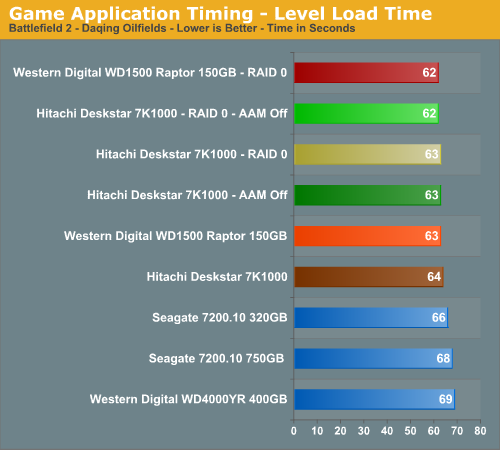
Once again we see a minimal difference between our RAID 0 and single drive configurations in this benchmark with only a one second difference in load times. In repeated testing it was difficult to discern any differences between the RAID 0 and single drive setups. On a side note, we firmly believe the areal density and 32 MB cache advantages of the Hitachi 7K1000 make up for the rotational and random access advantages of the Raptor in our gaming tests.
WinRAR 3.62
Our WinRAR test measures the time it takes to compress our test folder that contains 444 files, 10 folders, and 602MB of data. This is same test folder utilized in our iPeak test suite. This benchmark is extremely CPU/RAM intensive but it may require a fast storage system to keep pace.
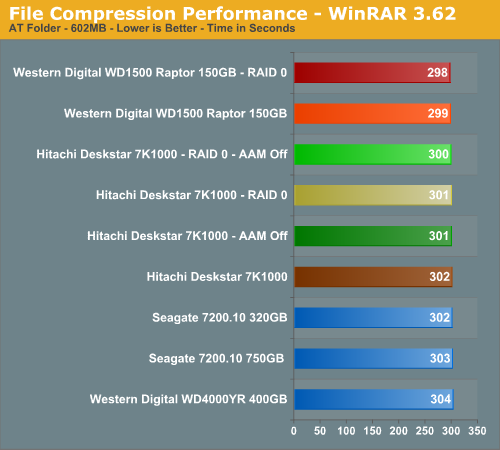
Our iPeak test showed a 50% advantage for the RAID 0 setups but we see an insignificant difference in the actual test results. One would assume the potential write speed advantages of a RAID 0 setup would have a larger impact on performance in this benchmark but in actuality CPU throughput makes a far more significant difference.
Nero Recode
Our encoding test is quite easy - we take our original Office Space DVD and use AnyDVD Ripper to copy the full DVD to the hard drive without compression, thus providing an almost exact duplicate of the DVD. We then fire up Nero Recode 2, select our Office Space copy on the hard drive, and perform a shrink operation to allow the entire movie along with extras to fit on a single 4.5GB DVD disc. We leave all options on their defaults except we turn off the advanced analysis option. The scores reported include the full encoding process and are represented in seconds, with lower numbers indicating better performance.
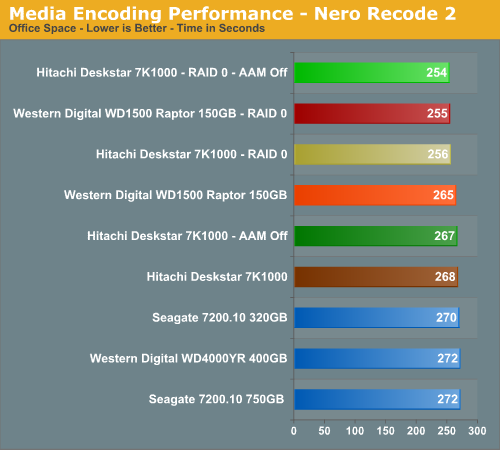
The iPeak results showed a 93% improvement with RAID 0 and we know from previous experience that RAID 0 can make a difference in this particular test. How large the difference would be was anybody's guess, but we figured it was the last chance for RAID 0 to generate any meaningful performance improvements. In the end, we did have measurable differences between the two setups with the RAID 0 configurations performing about 5% better. If you do a lot of video encoding then RAID 0 could end up saving you some precious minutes each day. Is it worth the cost or effort? Probably not, but it is one area besides benchmarking where RAID 0 actually made a difference. Of course, if you don't already have the fastest CPU for encoding available, that would have a far greater impact than RAID 0.
File Copy Performance
Our file copy test measures the time it takes to transfer our test folder that contains 29 files, 1 folder, and transfers 7.55GB of data from our source drive to the target test drive. This is same test folder utilized in our iPeak test suite. This benchmark is disk write intensive and requires a fast storage system.
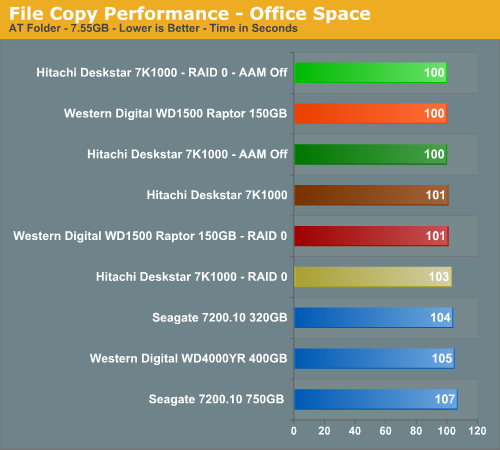
We finish our tests with a benchmark that should have favored the RAID 0 setups due to a pure write scenario. Unlike our iPeak test (and for that matter a similar test in PCMark05) where the largest differences in scores between setups were generated, we have RAID 0 making no difference in this test and actually scoring worse than a single drive setup in two instances.
Our application benchmarks are designed to show application performance results with times being reported in seconds, with lower scores being better. While these tests will show some differences between the drives it is important to understand we are no longer measuring the pure performance of the hard drive but how well our platform performs with each individual drive. In that sense, these are the more real-world tests that show how hard drives and RAID 0 can impact your everyday computer use.
The performance of a hard drive is an integral part of the computer platform but other factors such as memory, CPU, core logic, and even chipset driver choices can play a major role in determining how well the hard drive performs in any given task. Also worth noting is that new features of Windows Vista - specifically SuperFetch - can further reduce the measured performance differences between hard drives.
Game Load Tests
In our Half-Life 2: Lost Coast test we measure the time it takes to load the game with the application timer starting when the play game icon is initiated in the Steam menu until the main game menu appears.

The results speak for themselves with the RAID 0 setups offering extremely minor performance improvements in actual game load testing. You will likely not be able to notice any differences during actual game play with a RAID 0 setup. We know it was impossible for us.
Our Sims 2 - Open for Business test measures the time it takes to load the initial portion of the game. Our application timer starts when the game icon is initiated until the neighborhood menu appears.

We witnessed 38% to 50% improvements in our iPeak tests in this game but measure less than a 2% difference in actual game load times. Without a benchmark, these differences are impossible to witness during actual game play. Once again, we see the Raptors slightly ahead but the 7K1000 for all intents and purposes is even in our game benchmarks.
Game Level Load
This test centers on the actual loading of a playable level within our game selections. We run Battlefield 2 and measure the time it takes to load the Daqing Oilfields level. Our application timer begins when the start single player icon is initiated and ends when the join game icon is visible.

Once again we see a minimal difference between our RAID 0 and single drive configurations in this benchmark with only a one second difference in load times. In repeated testing it was difficult to discern any differences between the RAID 0 and single drive setups. On a side note, we firmly believe the areal density and 32 MB cache advantages of the Hitachi 7K1000 make up for the rotational and random access advantages of the Raptor in our gaming tests.
WinRAR 3.62
Our WinRAR test measures the time it takes to compress our test folder that contains 444 files, 10 folders, and 602MB of data. This is same test folder utilized in our iPeak test suite. This benchmark is extremely CPU/RAM intensive but it may require a fast storage system to keep pace.

Our iPeak test showed a 50% advantage for the RAID 0 setups but we see an insignificant difference in the actual test results. One would assume the potential write speed advantages of a RAID 0 setup would have a larger impact on performance in this benchmark but in actuality CPU throughput makes a far more significant difference.
Nero Recode
Our encoding test is quite easy - we take our original Office Space DVD and use AnyDVD Ripper to copy the full DVD to the hard drive without compression, thus providing an almost exact duplicate of the DVD. We then fire up Nero Recode 2, select our Office Space copy on the hard drive, and perform a shrink operation to allow the entire movie along with extras to fit on a single 4.5GB DVD disc. We leave all options on their defaults except we turn off the advanced analysis option. The scores reported include the full encoding process and are represented in seconds, with lower numbers indicating better performance.

The iPeak results showed a 93% improvement with RAID 0 and we know from previous experience that RAID 0 can make a difference in this particular test. How large the difference would be was anybody's guess, but we figured it was the last chance for RAID 0 to generate any meaningful performance improvements. In the end, we did have measurable differences between the two setups with the RAID 0 configurations performing about 5% better. If you do a lot of video encoding then RAID 0 could end up saving you some precious minutes each day. Is it worth the cost or effort? Probably not, but it is one area besides benchmarking where RAID 0 actually made a difference. Of course, if you don't already have the fastest CPU for encoding available, that would have a far greater impact than RAID 0.
File Copy Performance
Our file copy test measures the time it takes to transfer our test folder that contains 29 files, 1 folder, and transfers 7.55GB of data from our source drive to the target test drive. This is same test folder utilized in our iPeak test suite. This benchmark is disk write intensive and requires a fast storage system.

We finish our tests with a benchmark that should have favored the RAID 0 setups due to a pure write scenario. Unlike our iPeak test (and for that matter a similar test in PCMark05) where the largest differences in scores between setups were generated, we have RAID 0 making no difference in this test and actually scoring worse than a single drive setup in two instances.










48 Comments
View All Comments
userexists - Thursday, April 19, 2007 - link
As I understand it, from previous articles, the limiting factor in gaming tests seems to be the CPU. I understand why you'd want to use an Opteron or Xeon system for benchmarking the access patterns -- the only people who care about those results are probably going to be running servers. But most people playing games aren't using server components. I'd love to see how the QX6800, for example, and some fast RAM affects gaming benchmarks under RAID-0 -- i.e. answer the question of whether the CPU bottleneck has been relieved. Probably not, but who knows until you test it, right?Gary Key - Sunday, April 22, 2007 - link
I will have some Intel benchmarks with a QX6700 up this week although I doubt the results will be that surprising. ;-)cbuchach - Thursday, April 19, 2007 - link
For all the arguing, NO ONE can say that RAID0 is overall slower. In most situations it is faster by varying degrees, maybe a percent or two or maybe more. For enthusiasts, the percent counts. Look at heatsinks or overclocking. Someone may spend an extra $50 for a better heatsink, for what, maybe an increased overlcock from 3300 MHz to 3400 MHz or spend lots of cash for a water cooling setup, or spend an extra $100 for slightly better RAM; the list goes on and on. For real enthusiasts, the extra 1-2% counts.(And as far as data loss goes, everyone should backing up all their nonrecoverable data data anyways, so that point is moot.)
tshen83 - Thursday, April 19, 2007 - link
and don't even talk about performance, people who want performance will buy Raptors X or SCSI drives. this drive is for storage. RAID storage for cheaptshen83 - Thursday, April 19, 2007 - link
yes, backing up 2TB of data, with what? probably a RAID1(takes 4 drives to have 2TB) or RAID5(3 drives) of the same drives. so why not just use RAID1 or RAID5 in the beginning?ncage - Thursday, April 19, 2007 - link
I just wish hitachi would make this drive in something other than 1TB. I love hitachi hard drives and just which this awesome thing would come in like a 500GB or something like that.Ncage
Gary Key - Thursday, April 19, 2007 - link
750GB drives will be available in May, the smaller capacities later this summer.TomWomack - Thursday, April 19, 2007 - link
What I'd be much more interested by is a review of performance for a pair of these drives in RAID1. RAID1 read speed ought to be the same as RAID0, and most disc-limited tasks are read-limited, whilst running drives in RAID1 seems a sensible reaction to the combined unreliability and cheapness of modern HDDs.[also you can break a RAID1 mirrored pair and grovel for deleted data on one of the drives while running the computer happily on the other, which I've found useful in the past]
Watson - Thursday, April 19, 2007 - link
I would love to see if useful speed increases are actually available over multiple drives when splitting OS and cache files from applications vs. Raid 0. I have a Raid 0 on 10k Raptors in my machine, and they are very fast (obviously), but I have often wondered in a reinstall if I would be better off splitting the drives and what is put on them. Any thoughts?yyrkoon - Thursday, April 19, 2007 - link
If you are wondering if booting from this array would be slower, or faster, the chances are with RAID0 if anything, the array will boot slower vs a single Raptor. The reason behind this is simple: booting windows, HDDs benifit more from faster access times, and RAID0 will increase random access times. RAID1 on the other hand, could help some here, but it really depends on the controller(RAID1 paired with the right controller can actually decrease access times, but it will not be a huge difference).Now, all that being said, there is a reason why systems, where speed, and redundancy is crucial, people opt for RAID10. Obviously, there is the redundancy factor, but you can get the from RAID5 as well as speed if enough drives are used. Pretty much, you get the best of both worlds having a RAID10 array, faster access times, and throughput. This performance of course comes at a cost, you need a minimum of 4 HDDs, so for instance, using 4x 1TB Hitachi drives, we are talking in the balpark of $1600 for a bare minimum + controller capable of handling RAID10.
When it is all said and done, unless your system is serving thousands of people data every hour of the day, heavily editing video, or some other similar task you do not need this kind of disk performance. Also, for the life of me, I can not see how making one large disk array, for your OS, and putting all your data on this array is going to help things either. Personally, I think it is much smarter, to use a single fast disk for the OS, and perhaps multiple drives for data, keeping everything seperate. As for using RAID, well, I can see an application for it, even in the home, but not for the OS.
Think about it, what is so important about the OS that you need redundancy for it ? Nothing, plain and simple. Need a RAID array for video editing, or something else ? fine, get a third HDD for the OS, and keep the RAID0 array seperate. Same goes for RAID1, or RAID5, keep it seperate from the OS, and if something catostrophic does happen, chances are, it wont be on the data disks(however, nothing is ever set in stone). I have been using this technique since the mid 90's, and have had very little problems, and have lost next to zero data, that I needed. Not only this, but it does help to organize your data, so it is more easily found later on, but not as important.
As for splitting OS/swap accross multiple drives, this is debatable. First, if all of your SATA channels are saturating what your system is capable of handeling, then no, but in theory it should help. I personally have noticed the bigest differences when transfering file locally, if I am transfering files from a PATA -> SATA drive, or vice versa. Two different interfaces, using two difference I/O channels.
</two cents>